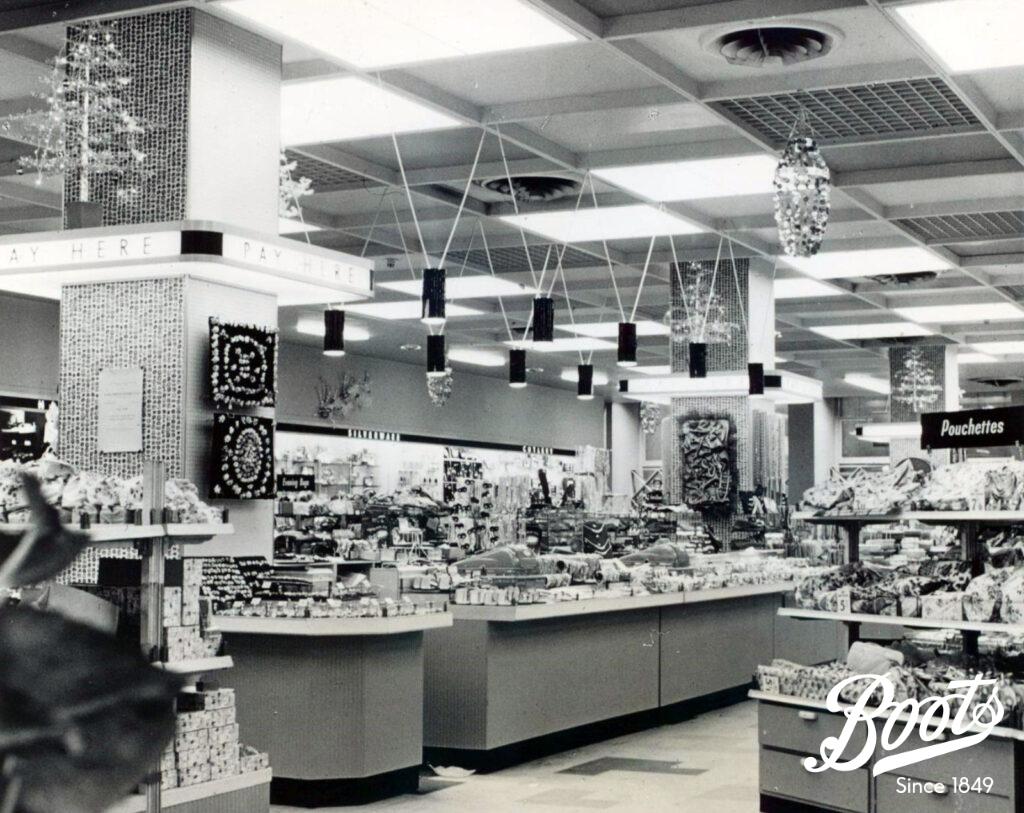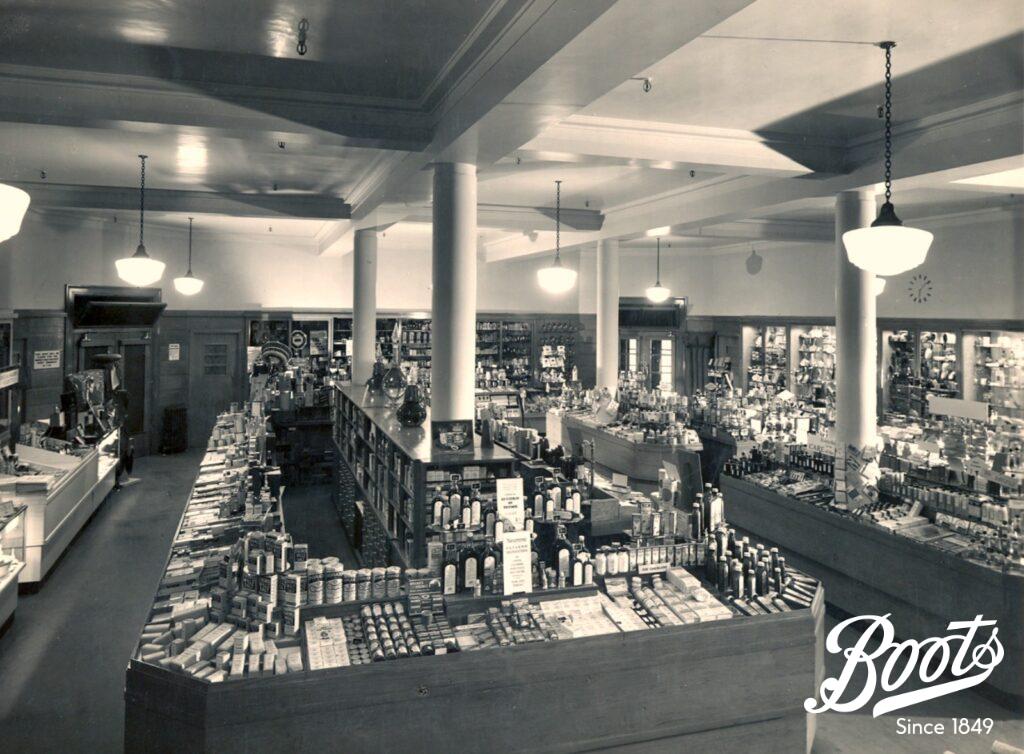
Time to read
A land of opportunity? Boots considers American ‘Self-Service’ in the 1950s
Between the world wars, a UK-based branch of Boots the Chemist was easily recognised. Large wooden counters dominated the shop, separating staff and customers and placing most goods beyond the customer’s reach.
Between the world wars, a UK-based branch of Boots the Chemist was easily recognised. Large wooden counters dominated the shop, separating staff and customers and placing most goods beyond the customer’s reach. During the 1930s, display trays were placed on some counter tops that permitted the handling and inspection of a few key products. But Boots’ staff remained prominent, handing the goods over to their customers while dispensing medical advice.
After 1950, this pattern of selling goods began to change. In North America before the Second World War, grocers had pioneered a new system called “self-service”, which now attracted the attention of Britain’s major retailers. While stores used self-service in a variety of ways, the onus was always placed on customers to literally serve themselves. Counters and kiosks were largely absent, with merchandise placed instead on rows of open shelving or ‘gondolas’. Customers could easily pick-up, examine, and carry their items around the store. They then paid for them all in one go at “check-outs” on their way out.
To its British advocates, self-service promised to bring wealth and opportunity to the retail sector. The new system would allow greater operational efficiencies, reduce staff overheads and increase financial returns. Consequently, many British companies made comprehensive research studies of how self-service might be practiced and applied in their own stores. Boots was no exception.

In March 1951, the company tentatively trialled self-service by creating an experimental prototype store in Burnt Oak, North London. In the same decade, Boots executives made regular research visits to the United States and Canada to observe self-service stores – and their customers – in action. They visited a range of different retailers in many major cities – including well-healed department stores like Macy’s, nationwide drug stores like Walgreens and Katz, and smaller independent pharmacies – and examined almost every aspect of their operations. They assessed the impact of new computerised ordering systems, measured the heights of shelves, and wrote down the in-store colour schemes. They even remarked on the use of staff name badges – a new requirement now that staff roamed the store and might be mistaken for customers.
The trips also considered self-service’s place within America’s more affluent society. A 1959 tour noted how consumer durables like motorcars and refrigerators were more common in the States because Americans were “much wealthier” than Britons. Greater car ownership had encouraged the building of out-of-town shopping centres, which stayed open later, anticipating the housewife’s use of the family car once their husbands returned from work. They also perceived gender changes in shopwork, since the longer opening hours now allowed married women to take part-time jobs in the evening.
Boots management knew that self-service would eventually come to Britain. It was seen as inevitable. So the company considered how, rather than if, the system would be applied in its own stores. Boots was careful to court partnerships with American businesses like the National Cash Register Company (NCR), in Dayton, Ohio. After 1960, once Boots had committed itself to implementing a version of self-service, the NCR supplied all its tills, as well as the cash-counting hardware that the new check-outs required.
After each trip, the Boots visitors circulated an internal report that gave their verdict on the self-service systems they had seen in North America. These reports show how nervous executives were about the potential impact of self-service on its traditional mode of operation. While a source of fascination, the company was wary of what it perceived to be the brash and gaudy excesses of American retail. The reports were written in contrasting tones. US merchandise, for example, was praised as “always outstanding in its variety, inventiveness and presentation”, while, at the same time, its sales techniques were criticised as “extravagant” and even “vulgar” by British standards.
These cultural anxieties, as well as the disparity between British and American standards of living, made Boots unwilling to simply replicate American retail practices. Instead, it modified the American self-service model to suit the perceived tastes of its post-war British customers. A 1959 report argued that Boots should maintain, “at all costs,” the perceived standards of its own shops and not allow them to “deteriorate into cheap [American] bazaars”. By 1960, Boots had decided to introduce what it called “self-selection” into its stores, rather than to implement full-scale self-service. This hybrid approach uneasily mixed the new self-service model with traditional counter selling. A 1960s Boots store contained shelves of accessible merchandise, but these coexisted with behind-the-counter goods, dispensed by an advisory chemist. For the firm’s executives, this safe-guarded the company’s tradition of British personal service from the more “gaudy” aspects of the American drug store.
Jack Moss is a PhD history student at the University of Nottingham, undertaking a collaborative doctoral award with the Boots Archive. His project explores postwar Britain’s shopping cultures, with particular focus upon the ways in which modernised self-service methods altered Boots’ practices.
Image Gallery
WBA/BT/21/46/1/66/11 The interior layout of the Boots store in Union Street Bath, c1950. The large counters dominated the sales floor and staff would serve customers from behind the kiosk space. The open-display trays are visible around the perimeter of the counter.
WBA/BT/35/165 Retail Chemist (April 1951) The check-out counters of Boots’ experimental self-service store at Burnt Oak, Edgware, London. The store opened in March 1951 and closed four years later. The information gathered from this experiment greatly enhanced Boots’ education and experience with self-service systems.
WBA/WG/5/1/4 The exterior of a Walgreens store in Cincinnati, Ohio c.1957. The image was taken on one of Boots’ research visits and demonstrates the type of store company representatives were sent to observe and scrutinise. The ‘self-service’ element of the shop is clearly visible from the signage, however Boots’ managerial staff would have noted a range of techniques and sales ideas including window displays and lighting.
WBA/BT/12/17/1/13 The front page of the 1962 American visit report. This is representative of the format and presentation-style adopted by Boots staff for their American visits.
WBA/BT/28/46/30/30 Self-service at a Boots branch in Birmingham.



